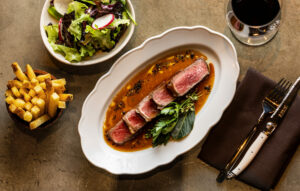
The good news, as of this writing (a reprint from my previous website, if you’re wondering about the timeline), is that our local tomato spring truly has sprung. Not exactly on-time, however – more like, finally. As in, Finally, it’s about [expletive] time, because I live alongside some of the finest tomato plants in the known universe, and it’s just plain wrong to make me wait until late August to get my fix. In fairness, to live in Sonoma County is hardly akin to the forced deprivation of an extended tour on a nuclear submarine or offshore oil rig; sufficiently desperate for Solanum lycopersicum, I could purchase the irredeemable supermarket facsimile year-round. However, as I’ve already tried to explain, I won’t – I can’t – subject my family’s taste buds to such effrontery, and neither should you to yours. But here and now, the farmer’s market is literally teeming with tomatoes, at the stalls of the dedicated specialists (e.g, Dan Magnuson’s Soda Rock Farms), as well those of the many other outstanding growers I’m lucky enough to shop with (Preston Vineyards, Foggy River and Early Bird Farms, to name but a few); I’m even getting regular contributions from my own garden, and I really suck at growing tomatoes.
I’ll cook all sorts of things with tomatoes over the next couple of months, and once in a while I may even get a little cutesy and dress them up (for years I’ve been tempted, but failed to muster the courage, to mount an assault on Alain Passard’s legendary tomate farcie confit aux douze saveurs, still, as I understand it, a fixture of the menu at L’Arpege). Still and all, I typically treat tomatoes much the way I’d treat a peach, erring on the side of simplicity over complexity, part of my ongoing effort simply not to screw up a thing that began as nearly perfect before I got involved. However, unlike a peach – the peach being one of those rare foods that seems almost impossible to improve either by fiddling with or adorning it – the tomato is a remarkably versatile foil, tolerating temperatures from hot to cold, equally content as condiment and centerpiece, visually arresting whether highly processed or nearly naked, an unimpeachable accompaniment for seafood, steak, and cheese alike. The first tomatoes of the season, however, deserve a special respect, a period of honest assessment and contemplation, and this – more than a little like the first night back with your spouse after a long business trip or following an exaggerated bitchfest about something neither of you can even remember – seems best done naked, or at least nearly so.
Thus, as we continue eat our way through the first few batches of ripe little gems from our own garden, the dominant themes resonate around salads and sandwiches. The variations are truly limitless, but I really liked the most recent incarnation, as pictured at the top of this post, so here you go (the recipe for pesto follows at the end):
Heirloom Tomato Sandwiches on Cranberry-Semolina with Pesto, Olive Oil, and Salt
You could use virtually any tomatoes here, and – ideally – I think you’d serve a few different ones, both for variety of color and flavor. A red-toned beauty (Purple Cherokee, Pink Lady, or Early Girl), a yellow (Tangerine or Lemon Boy), and a green (Green Zebra) would provide a gorgeous array of color as well as a distinctive breadth of flavors, sweetness, and acidity. Similarly with the bread, you could use anything, really, but a lightly toasted, crusty sourdough works particularly well. I hadn’t planned it ahead of time, and I would not have thought of a fruit-laced bread had it not been lying around, but the almost impossibly good Cranberry-Semolina from the Full Circle Bakery in Penngrove worked exceedingly well, with the chewy, sweet-tart bite of the cranberries adding just the right ballast against the acidic tomatoes and the licorice notes in the pesto.
- Toast some slices of the bread, preferably a crusty sourdough with a baked-in dried fruit (cranberries, apricots… nuts in the bread, for some reason, sound unpleasant to me, although I can’t say why, because nuts and fruits go well together, there are already nuts in pesto… hmmmm… maybe next time?)
- Top each slice of bread with a thick slice of tomato – ideally, slices of a few different colors, although my garden wasn’t cooperating on that front – and then top each slice of tomato with a small quenelle of pesto. (Why bother with a quenelle? Because it takes almost zero effort and the uniform shape will look nice against the slightly irregular backdrop of the heirloom tomato and crusty bread, and because it will show off the effort you put into your pesto.)
- Sprinkle with fleur de sel and drizzle the plate with olive oil, preferably from Dry Creek, such as that from Preston or the pricier, but exceptional, Da Vero.
Classic Pesto (from M Hazan)
I’ve talked at length about pesto and its Mediterranean cousin, pistou here, and I like all sorts of variations, and many have a particular place (with cheese; without cheese; for fish; for pasta Genovese), but nothing – and I’ve made and consumed many hundreds in my life – is ever quite the equal of the classic Italian variety, and no version seems quite so perfect as the simple food-processor method of M Hazan’s, described accurately, along with some pretty decent comments and observations, here, in case you don’t have the book (Essentials of Classic Italian Cooking, which, by the way, is one of my few “must have” cookbooks, certainly a Top 10, maybe a Top 5).
Hazan’s is so easy, and so perfect, that I can not possibly add anything without also diluting it. However, I will emphasize that, if you’re going to make pesto, in addition to following Ms Hazan to the letter, you must heed a few basic rules (these are, of course, common to all cooking, but the simplicity and intensity of pesto offers even less slack than usual):
- Use good basil. You really ought to grow your own – it’s cheap and easy, even for a challenged gardener like me. Make sure it’s the Genovese varietal: There are many basils, but you only want to make classic pesto with the particularly aromatic Genovese basil and its distinctive note of licorice.
- Use good olive oil (it needn’t be your best – Costco’s organic extra virgin is just fine, and in fact better and cheaper than most), and probably an oil that leans more toward the grassy than the buttery end of the spectrum.
- Use only freshly grated Parmigiano Reggiano and Pecorino Romano cheeses. Seriously, don’t buy the waxy, shrink-wrapped, Swiss-cheese-tasting crap from the market, don’t buy it pre-grated in tubs from Trader Joe’s, and never, not ever, shall you pour grated cheese from a shiny green can – not for any reason, but specifically not into your pesto.
- Be careful about your garlic: First, try to find a grower that offers more than one kind, and that can describe the difference. Some are just way too hot and spicy. Rose de Lautrec is my go-to garlic if I can only have one, but obviously whatever the Italians classically use for pesto would be fine (I buy Rocambole from Bernier Farms, in the possibly misguided belief that this is what I would get in Italy). But be careful, because different garlics are not at all equivalent, and this extends to measurements: What, precisely, is a “clove” of garlic? The same bulb could have cloves varying in size by a factor of 4; and different types of garlic could have their heat vary by a factor of 4; so you could have a recipe calling for “2 cloves” and it could mean 2 or 32, from one extreme to the other. There is no way to deal with this uncertainty except to learn to do it by taste, to learn the garlic you use, to learn how much for your pesto.
- Don’t forget to season it, but don’t risk over-salting until all the cheeses are incorporated, as Romano in particular is very salty.









